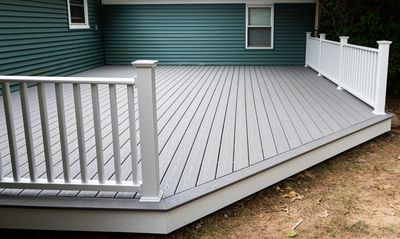Signed in as:
filler@godaddy.com
Signed in as:
filler@godaddy.com
Composite decking has become one of the most popular choices for homeowners looking for a long-lasting and low-maintenance outdoor living space. Unlike traditional wood, composite decking is engineered using a blend of wood fibers and recycled plastic, creating a material that resists the common issues that plague natural wood decks—such as rotting, splintering, warping, and insect damage. This advanced construction means composite decks maintain their structure and aesthetic appeal for decades without the need for extensive upkeep. Composite decking is also designed to withstand extreme weather conditions, including high moisture, temperature fluctuations, and prolonged sun exposure, making it a particularly attractive option for areas with harsh climates. Additionally, it offers a smooth, splinter-free surface, making it a safe and comfortable option for families with children and pets.

Requires only occasional cleaning with soap and water, eliminating the need for costly and time-consuming upkeep.
Resists warping, splintering, and rotting over time, ensuring a long-lasting investment.
Often made from recycled materials, reducing environmental impact while providing a sustainable decking solution.
Available in a range of colors and textures that mimic natural wood, providing versatility in design choices.
Many composite brands incorporate UV protection to minimize color fading from sun exposure.
“Composite gets too hot in the sun.” While earlier versions of composite decking retained heat, modern options include heat-resistant technology to keep surfaces cooler.
“It looks fake.” Today’s composite boards mimic the natural grain and texture of real wood, available in a variety of colors and finishes.
“It’s not as strong as wood.” High-quality composite decking is designed to be just as structurally sound as wood, with some brands offering reinforced cores for added strength.
Capped Composite: Features a protective outer layer that enhances resistance to fading, staining, and moisture absorption, extending the deck's lifespan.
Uncapped Composite: More affordable but lacks the additional protective layer, making it more susceptible to the elements and requiring more frequent cleaning.
PVC Decking: A synthetic option that contains no wood fibers, offering superior resistance to moisture, mold, and mildew, making it ideal for areas with high humidity or near water sources.
Composite decking is a great choice if you’re looking for a low-maintenance, long-lasting deck that resists the elements. Unlike wood, composite won’t rot, splinter, or require staining, making it a hassle-free option for homeowners who want to enjoy their deck without the upkeep. It’s designed to withstand moisture, fading, and insects, making it especially well-suited for areas with varying weather conditions. With a variety of colors and textures that mimic natural wood, composite offers a stylish and durable alternative. While it has a higher upfront cost than wood, the long-term savings on maintenance and repairs can make it a smart investment. If you want a deck that looks great with minimal effort, composite might be the right fit for you.
Composite decking is installed using hidden fasteners or screws, creating a sleek, seamless look. The boards often feature tongue-and-groove edges that snap together, making installation faster and more uniform. While the initial cost of composite decking is higher than traditional wood, the long-term savings on maintenance, staining, and repairs make it a cost-effective investment.
Copyright © 2025 Teak Construction - All Rights Reserved.

We use cookies to analyze website traffic and optimize your website experience. By accepting our use of cookies, your data will be aggregated with all other user data.